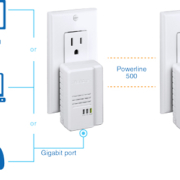Hybrid network strategy for smart homes: How WiFi and HD-PLC can be complementary
While the smart home market continues to grow steadily (household penetration of 21.4% by 2025), the market has yet to see mass adoption due to connectivity performance and cost barriers.
As smart home deployment depends largely on the consumer’s home broadband performance, features beyond speed are critical to creating product differentiation.
Given its high bandwidth and ease of installation, many device makers choose WiFi for their applications. But WiFi suffers from reliability issues, especially with multiple connected devices causing noise and weakened signals.
Smart devices also require open protocols and standards to transfer data. Without a universal standard, disparate systems–such as the thermostat and air conditioner–fail to communicate with each other, which defeats the purpose of the connected home.
Now, there’s a hybrid network approach that can address these concerns. Meet HD-PLC, a high-speed wireline communications solution that eliminates WiFi dead zones and increases data rates. Because HD-PLC communicates over existing wiring (power lines, twisted-pair, coax, etc.), it eliminates the need to install new cabling or network components. Thus, you’ll be able to reduce the cost and complexity of home automation upgrades for your customers.
In this article, you’ll learn more about the benefits of a networking model based on both HD-PLC and WiFi. Let’s dive in!
WiFi and Powerline Communication: Choosing the Best Home Automation Protocol
In this section, we’ll discuss the key benefits and limitations of both wireless and wired home automation systems.
WiFi channel
No doubt, the main benefit of WiFi is its availability in almost every household. While it offers system integrators the convenience of device interoperability and communications, WiFi connectivity has some limitations.
WiFi does not have the bandwidth required to support peak loads. With multiple devices competing for bandwidth, noise and interference will further affect the network performance. You’ll also have to consider the practicality of physical obstacles like concrete walls that can block signals.
Adding repeaters and gateways can mitigate range limitations; however, they also significantly increase the total cost of the deployment.
Ethernet-based communication
A popular wired solution, Ethernet brings unbeatable benefits when it comes to data transmission speed over distances up to 100m. It’s also more secure, since the cables are buried in walls and hard to access.
But it isn’t the optimum solution either. Ethernet can be costly and time-consuming to install. Not many customers are willing to go through the hassle of running new cables through walls. In many cases, the installation of switches is required to extend the network size, which will take up physical space.
The best of both worlds: HD-PLC broadband powerline
With HD-PLC, you’ll have more flexibility in designing a network infrastructure that meets the bandwidth required for modern smart home networks, especially in retrofit applications.
A leap from traditional powerline communication technology (narrowband PLC), HD-PLC is capable of achieving fast and reliable communications.
With HD-PLC, you can avoid the expense of running Ethernet cables, all while enjoying its blazing-fast speed and industrial-grade robustness. Furthermore, HD-PLC leverages low-voltage power lines (or any other wiring) to communicate, meaning less power consumption for sustainable smart home adoption.
Read more: IEEE 1901 High Definition Power Line Communication
Next, you’ll learn how integrating HD-PLC with a WiFi network can bring exciting capabilities to your smart home solutions.

Creating a hybrid plug-and-play mesh network with powerline communication
Realizing the Complementary Advantages of HD-PLC
Through a hybrid approach, you can take advantage of the low-cost and ubiquitous WiFi network together with the data transmission performance of HD-PLC without installing a single cable.
-
Delivering higher bandwidth and more robust networks
HD-PLC can reliably transmit data at PHY speeds up to 240Mbps over existing wiring. It employs advanced broadband communication techniques such as orthogonal frequency division multiplexing (OFDM) to maximize the spectral efficiency of the system. The higher operating frequency range enables HD-PLC to achieve high bandwidths, low sensitivity to impulsive noise and frequency-selective attenuations like radio sources. This effectively reduces interference and lag time.
-
Linking disparate systems with IP-based open standards
Although compatibility doesn’t necessarily mean interoperability, HD-PLC brings the benefits of IP-based free topology to system integrators.
Because the HD-PLC protocol implements an Ethernet-like transmission, HD-PLC devices can act as an Ethernet bridge, enabling double use as gateways for IP cameras, WiFi hotspots, or other wired networks.
As such, integrators can now simplify network configuration and deliver device interconnectivity over any wire (including power lines, coax, twisted-pair, and phone lines) already installed in the home.
Read more: BACnet, LonWorks, and HD-PLC: Choosing the Best Open Protocol for Your Building Automation System
-
Ensuring crypto strong security
In an IPSOS survey, 55% of respondents reported not trusting connected devices. And it’s for good reason. Cybersecurity is a growing concern since WiFi connections are vulnerable to cyber-attacks.
HD-PLC provides the bandwidth and countermeasures needed to address security risks. Crypto-strong AES-128 encryption, together with black- and whitelisting of devices, reduces the risk of behind-the-firewall attacks.
Additionally, the use of IPv4 and IPv6 addressing enables the addition of state-of-the-art security features through simple firmware updates.
HD-PLC: A Look into the Future of the Smart Home
WiFi is undeniably a popular home automation solution with its availability and low operational costs. However, HD-PLC holds the greatest promise for meeting the demands of smart home applications.
The advantage of using a preinstalled wiring infrastructure combined with WiFi makes HD-PLC a competitive technology for broadband communications. Add the flexibility of cable-free installation, megabit speeds, and embedded security and you get a powerful and cost-effective smart home solution.
Download the HD-PLC Application Brief to learn about the advantages HD-PLC brings to video doorbells and other smart home systems.


